|
|
|
Sort Order |
|
|
|
Items / Page
|
|
|
|
|
|
|
| Srl | Item |
| 1 |
ID:
175234


|
|
|
|
|
| Summary/Abstract |
This paper seeks to analyse the adoption of Energy Efficiency Measures in non-residential buildings. Based on the concepts of agency theory and absorptive capacity, the propensity of Micro-, Small- and Medium-sized Enterprises in Portugal to adopt energy efficiency in lighting, insulation, and the replacement and operation of heating, was evaluated. To achieve this, an online survey was carried out, and the resultant data was treated using Probit models. The main findings suggest that absorptive capacity factors are a key reason for adopting more efficient and profitable technologies. Policymakers should provide assistance and information to the managers of these enterprises regarding the benefits of energy efficiency measures. Additionally, this paper shows that subsidiary enterprises are more likely to adopt energy efficiency measures. Although subsidiaries suffer pressures due to agency theory factors, they may also benefit from knowledge transfers from their parent enterprises. Most of the decisions and barriers considered by enterprises are not based on audits or the advice of energy management professionals, since more than 65% of the respondents have never performed an energy audit, and over 82% do not have an energy manager.
|
|
|
|
|
|
|
|
|
|
|
|
|
|
|
|
| 2 |
ID:
175231


|
|
|
|
|
| Summary/Abstract |
Based on the household-level dataset of 1472 rural households in China in 2015, this paper provides detailed patterns of electric appliance usage in rural China and examines the factors affecting it by using a multinomial logit model. Results reveal that rural households with higher per capita incomes, with large household size and dwelling areas, are more likely to purchase energy-efficient-labeled appliances than families with lower incomes, with small household size and dwelling areas. Rural households with higher education but relatively low incomes may be hampered in their purchase of energy-efficient appliances. Households using biomass are less likely to purchase appliances in general and energy-efficient labeled washing machine and TVs in particular. Findings suggest that providing subsidies to rural households for energy-saving appliances in rural China may encourage the choice of energy-efficient appliances.
|
|
|
|
|
|
|
|
|
|
|
|
|
|
|
|
| 3 |
ID:
175259


|
|
|
|
|
| Summary/Abstract |
This study mainly aims to assess the impact of an oil revenue shock on Iran's macroeconomic variables using a New Keynesian DSGE model as well as considering some main resource-rich developing countries characteristics such as capital scarcity, government's dominance in the economy, and public investment inefficiencies features. Here, the macroeconomic outcomes of implementing an alternative fiscal rule, namely, modified Bird-in-Hand (MBIH), in which both the development of infrastructures and future generations needs are taken into account are investigated and compared with the fiscal rule of the base scenario. The results are considered in four directions: First, an oil revenue increase shock causes the macroeconomic variables to rise in both scenarios, but the variables private-sector production, consumption, total investment, and non-oil GDP have a more increase under the MBIH scenario. Second, oil revenue accumulation in the oil fund under the MBIH scenario is significantly more than that in the base scenario. Third, government budget deficit experiences a higher increase, and public sector production experiences a less rise under the MBIH scenario. Fourth, the sensitivity analysis of public investment inefficiency shows that this factor acts as a serious barrier to the realization of the government's investment goals. Therefore, performing the first-best (MBIH) fiscal rule entails the reduction of the government's budget dependency on oil revenues through expanding the tax base, improving the public investment efficiency, and shrinking the public sector.
|
|
|
|
|
|
|
|
|
|
|
|
|
|
|
|
| 4 |
ID:
175244


|
|
|
|
|
| Summary/Abstract |
Italy has a very low level of uptake of electric cars (ECs), equal to 0.6% for the year 2019, despite significant efforts put in place by policy makers to stimulate their use. This paper investigates the barriers to wider EC diffusion via a survey administered in 2019 to a representative sample (N = 870) of the Italian population. We discuss and rank the barriers, aggregate them via principal component analysis (PCA) on the basis of the polychoric correlation matrix, perform a cluster analysis and analyse the socio-economic determinants of the respondents. The findings of this paper suggest a series of improvements that could be made by various actors. To overcome the financial barriers to EC uptake, Italian policy makers should reinforce incentives at the national and local levels and car manufacturers should bring to the market cheaper ECs belonging to the A and B segments. The charging-related barriers require investments on fast charging stations along the main toll highways and a new regulation regarding multi-house dwellings. Finally, reliable and complete information is needed to enhance knowledge about the technological and environmental pros and cons of ECs.
|
|
|
|
|
|
|
|
|
|
|
|
|
|
|
|
| 5 |
ID:
175253
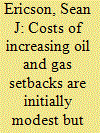

|
|
|
|
|
| Summary/Abstract |
Spatial setback rules are a common form of oil and gas regulation worldwide - they require minimum distances between oil and gas operations and homes and other sensitive locations. While setbacks can reduce exposure to potential harms associated with oil and gas production, they can also cause substantial quantities of oil and gas resources to be unavailable for extraction. Using both theoretical modeling and spatial analysis with GIS tools on publicly available data, we determine oil and gas resource loss under different setback distances, focusing on Colorado counties as a case study. We show that increasing setbacks results in small resource loss for setbacks up to 1500 feet, but resource loss quickly increases with longer setbacks. Approximately $4.5 billion in annual resource revenues would be lost in Colorado under 2500-foot setbacks, a distance recently proposed in Colorado Proposition 112 and California AB 345.
|
|
|
|
|
|
|
|
|
|
|
|
|
|
|
|
| 6 |
ID:
175268


|
|
|
|
|
| Summary/Abstract |
In passing the Bipartisan Budget Act of 2018, Congress reformed and strengthened a section of the tax code, 45Q, which provides tax credits of up to $35/ton CO2 for the capture and utilization of CO2 in qualifying applications such as enhanced oil recovery (EOR) and up to $50/ton CO2 for CO2 that is captured and permanently stored in a geologic repository. Earlier versions of the tax credit with lower credit values generated limited interest. This change to the tax code could potentially alter U.S. energy systems. This paper examines the effect of the increased 45Q credits on CO2 capture, utilization and storage (CCUS) deployment in the United States and on petroleum and power production. A range of potential outcomes is explored using five modeling tools. The paper goes on to explore the potential impact of possible modifications of the current tax credit including extension of its availability in time, the period over which 45Q tax credits can be utilized for any given asset and increases in the value of the credit as well as interactions with technology availability and carbon taxation. The paper concludes that 45Q tax credits could stimulate additional CCUS beyond that which is already underway.
|
|
|
|
|
|
|
|
|
|
|
|
|
|
|
|
| 7 |
ID:
175260


|
|
|
|
|
| Summary/Abstract |
Debt can influence the energy consumption of private sectors and public agencies by changing their fiscal budget constraints. From 1996 to 2016, China has had rapid debt growth and become the second-largest borrower in the world. Additionally, China has been the largest energy consumer since 2009. The impact of debt growth on its energy consumption, however, is not much addressed in the literature. Using an extended LMDI model, we investigate the impact of China’s debt on its energy consumption from 1996 to 2016 in a new way. The results show that (1) among the closed set of debt-related factors and other conventional variables studied, private debt per capita makes the strongest contribution to China’s energy consumption, and population has a moderate impact on the growth of energy consumption; (2) energy efficiency improvement, output efficiency of government debt, debt structure adjustment, and increased tertiary industry share are mitigating forces of energy consumption. These results provide a new, holistic perspective for the Chinese government to formulate synergistic policies of risk control and pollution control.
|
|
|
|
|
|
|
|
|
|
|
|
|
|
|
|
| 8 |
ID:
175240


|
|
|
|
|
| Summary/Abstract |
With an increasing number of jurisdictions considering alternatives to net metering policies to financially compensate behind-the-meter solar photovoltaics (PV), customer economics will increasingly depend on its ability to reduce demand charges. Understanding these demand charge savings from PV—and how behind-the-meter storage can potentially enhance those savings—is essential to understand PV market dynamics and adoption in the coming years. This article explores how these demand charge savings vary with demand charge designs and customer load profiles, modeled for a variety of residential and commercial customers. Our findings indicate that demand charge savings are lowest under a basic, non-coincident demand charge design where the demand charge is based on the maximum demand level over the month, regardless of timing, resulting primarily from the temporal mismatch between the timing of the PV host's demand peak and PV generation. PV provides greater demand charge savings, for both commercial and residential customers, when demand charge designs are based on predefined, daytime peak periods or longer averaging intervals. Demand charge savings from PV combined with storage are almost always greater than the sum of the savings attained through either technology separately. We also explore how well demand charge savings from PV align with corresponding utility savings.
|
|
|
|
|
|
|
|
|
|
|
|
|
|
|
|
| 9 |
ID:
175255
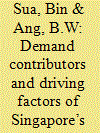

|
|
|
|
|
| Summary/Abstract |
Singapore is an island city state. It lacks conventional energy resources and is alternative energy disadvantaged. Yet its aggregate carbon intensity, given by the ratio of carbon emissions to GDP, dropped by 30% from 2005 to 2014. Currently it has a relatively low carbon intensity. Using I–O analysis, we study Singapore’s aggregate carbon intensity and the factors contributing to its changes at different levels, i.e. final demand, sector, and transmission levels. It is found that domestic exports accounted for nearly two-thirds of Singapore’s aggregate carbon intensity, followed by private consumption and investment. At the sectoral level, the top three contributors were the petroleum, petrochemical, and land transport sectors. Improvements in emission intensity and final demand structure were major factors contributing to reductions in carbon intensity. Our study contributes to the literature in two aspects. Methodologically, it deals with embodied emission intensity and analyzes its changes from the demand perspective. This differs from most studies in the literature from the production perspective. Empirically, the findings and policy implications are unique as they are applicable to a major city. With urbanization taking place in many developing countries, cites’ role in emissions and environmental sustainability are growing in importance but not many in-depth analyses similar to our study have been reported.
|
|
|
|
|
|
|
|
|
|
|
|
|
|
|
|
| 10 |
ID:
175232


|
|
|
|
|
| Summary/Abstract |
The construction of public-access electric vehicle charging piles is an important way for governments to promote electric vehicle adoption. The endogenous relationships among EVs, EV charging piles, and public attention are investigated via a panel vector autoregression model in this study to discover the current development rules and policy implications from the historical panel data in China. Five policies related to EV charging piles, EV purchase subsidies, commercial land prices, and retail gasoline prices are controlled as exogenous variables in the model. The results indicate that EV and charging piles diffusion do interact, and public attention plays a nexus role in EV and charging piles deployment. Reducing the electricity rate is the most effective policy approach to promote EV charging piles. Subsidising the construction cost has an insignificant impact on charging piles diffusion in this study, and several possible reasons have been discussed. The promotion effect of direct-current charging piles on EV sales is twice that of alternating-current charging piles in the one-year simulation of our model. Increasing the number of EV charging piles has a significant impact on battery electric vehicle sales but not on plug-in hybrid electric vehicle sales.
|
|
|
|
|
|
|
|
|
|
|
|
|
|
|
|
| 11 |
ID:
175246
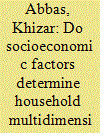

|
|
|
|
|
| Summary/Abstract |
This paper examines the socioeconomic factors of energy poverty at the household level using a dataset of 674,834 households from six South Asian countries. An adjusted multidimensional energy poverty index (MEPI) is used to measure the extent and depth of energy poverty, and a Tobit model is employed to examine the significance of socioeconomic status for multidimensional energy poverty. An ordinary least squares (OLS) regression model is compared with the results of the Tobit model, using the combined dataset and the datasets for each country separately. House size, household wealth, education, occupation (clerical, sales, or agricultural), and gender of the head of the households are significant negative socioeconomic determinants of household multidimensional energy poverty. Place of residence, house ownership status, family size, and the age of the primary breadwinner play a significant positive role in multidimensional energy poverty. These results suggest that effective policy measures for improving the socioeconomic status of households will mitigate multidimensional energy poverty. With implications for the design and implementation of policy, the evidence-based results of this study will contribute to reducing the detrimental impacts of multidimensional energy poverty nationally, regionally, and globally.
|
|
|
|
|
|
|
|
|
|
|
|
|
|
|
|
| 12 |
ID:
175262


|
|
|
|
|
| Summary/Abstract |
Whether financial agglomeration is conducive to the improvement of energy efficiency is of great significance for China to better follow the path of energy conservation and emission reduction, and green sustainable development. Based on the balanced panel data of 285 cities in China from 2005 to 2017, this paper analyzes the impact of financial agglomeration on energy efficiency. Theoretical analysis shows that financial agglomeration can influence energy efficiency through scale economy effect, innovation driving effect, information spillover effect and structural adjustment effect. Dynamic spatial econometric results show that, from a national perspective, financial agglomeration has a positive impact on energy efficiency. However, from the perspective of different regions and different city sizes, it is found that financial agglomeration can have different effects on energy efficiency. Financial agglomeration has a significant positive impact on energy efficiency in eastern and central regions, megacities and big cities. Financial agglomeration has a significant negative impact on energy efficiency in western China, and has no significant effect on energy efficiency in medium-sized and small cities. Finally, based on the conclusions of the study, specific proposals for financial agglomeration to improve energy efficiency are proposed.
|
|
|
|
|
|
|
|
|
|
|
|
|
|
|
|
| 13 |
ID:
175245


|
|
|
|
|
| Summary/Abstract |
Home-heating energy-poverty risk presents both challenge and opportunity for policymakers, businesses and communities. Effective measurement and management of this risk requires an evidence base that accounts for characteristics of the householder, building, and heating system. A composite index utilising 10 indicators refined to Small Area level is created to deliver spatially refined analysis of home-heating energy-poverty risk. The index is used to assess home-heating energy-poverty risk across 18,641 Small Area clusters in Ireland. This risk index is a scalable and internationally transferrable methodology that can be extended to cover other energy uses. Importantly the index is also dynamic and offers the capacity to analyse changes in energy-poverty risk associated with specific policy intervention proposals, including major contemporary environmental policy transitions such as residential fabric retrofit, residential heating system changes, energy price changes and carbon taxation. The application of the index to the Irish case affords refined insight into the impact and incidence of various market, technology and policy driven interventions such as fuel price changes, retrofit strategies and carbon tax increases. Risk and impacts vary geographically, and this index is designed to inform targeted policy interventions to mitigate home heating energy-poverty risk and thereby support ambitions for a ‘just transition’.
|
|
|
|
|
|
|
|
|
|
|
|
|
|
|
|
| 14 |
ID:
175239
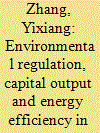

|
|
|
|
|
| Summary/Abstract |
How to improve environmental quality and achieve high-quality development of economy have become important challenges for China in the new era. Based on the KLEMS framework, this paper analyzes the relationship between environmental regulation, factor substitution, and energy-saving effect by using panel structure vector autoregression model and panel data of China industry from 2004 to 2014. The following conclusions are drawn:(1) China's environmental regulation can promote the substitution of capital to energy, however, benefit of this substitution in the long run is greater than that in the short run. (2) Only in the long run can China's environmental regulations have significant energy-saving effect, technological innovation is the main reason for the improvement of energy-saving effect of environmental regulation. (3) China's environmental regulation will not significantly improve the structure of capital, which makes the economic benefits low. Finally, the paper discusses the possible ways to improve China's environmental regulation from the aspects of forming a scientific environmental supervision system, improving energy pricing mechanism and capital structure.
|
|
|
|
|
|
|
|
|
|
|
|
|
|
|
|
| 15 |
ID:
175241
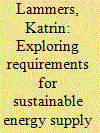

|
|
|
|
|
| Summary/Abstract |
Southeast Asia is one of the regions most affected by impacts of climate change underlying the urgency to build resilience especially for remote and isolated island communities. Moreover, these islands face the problem of expensive and unreliable electricity supply. The large number of island communities further magnifies the difficulty of reaching universal sustainable electricity supply. Off-grid electrification technologies promise to tackle this challenge entailing high investments yet also market potential. Currently both aspects – electricity access and climate resilience - are barely linked in electrification planning. Energy planning in a region highly affected by climate change requires integrative planning considering these risks. Here, to enhance integrative planning, we study the status quo of energy access and risk exposure of non-electrified Southeast Asian islands. We identify 1932 islands with a population greater than 21 million having limited access to electricity. Our study reveals three risk-specific island archetypes, which need different technical measures to enhance climate resiliency of future electricity systems. We conclude that future energy planning in Southeast Asia requires climate resilience as an additional planning dimension. The identified cluster groups serve as a blueprint for decision makers to support measures improving energy systems’ resilience avoiding expensive re-investments in the future.
|
|
|
|
|
|
|
|
|
|
|
|
|
|
|
|
| 16 |
ID:
175243


|
|
|
|
|
| Summary/Abstract |
The EU’s Energy Efficiency Directive (EED) sets a binding target for energy-savings in EU member states. The EED further requires member states to perform ex-ante evaluations of energy efficiency policies implemented to achieve these savings. However, ex-ante evaluation of energy efficiency policies is difficult as it requires detailed modelling of end-users’ investment and energy demand behaviour. This paper details the Danish IntERACT modelling approach for ex-ante evaluation of energy efficiency policies directed at residential heating. IntERACT integrates the energy system model TIMES-DK into a computable general equilibrium framework. The paper explores the potential for meeting Denmark’s EED-target through a policy-induced increase in households’ investments in energy efficiency retrofits. The paper considers the effect of energy efficiency policies on households’ investment behaviour by applying different levels of hurdle rates on households’ investments in energy efficiency retrofits. The paper shows that reducing the hurdle rate from 25% to 4% could meet more than a third of Danish energy-saving requirements for the period 2021–2030. This result includes a direct rebound effect of 31%. Finally, the paper demonstrates that reducing the hurdle below 10% has a substantial negative impact on households’ disposable income, making such policy less viable from a policy perspective.
|
|
|
|
|
|
|
|
|
|
|
|
|
|
|
|
| 17 |
ID:
175257
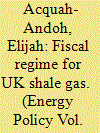

|
|
|
|
|
| Summary/Abstract |
The UK is believed to hold prolific reserves of shale gas; the quality of which has been compared and sometimes branded superior to the much successful US shale plays. Nonetheless, after more than ten years since the 13th Onshore Licensing Round, the fracking industry is said to have benefited from just £400 million - £500 million of estimated investments and only one partially fracked well with yet an uncertain fate of commercial production. This paradox motivated the current research. Based on a discounted cash flow model, the economic feasibility of the tax regime was evaluated with a special interest in the pad allowance [PA], a major incentive of the fiscal regime. We find that the design of the fiscal regime well achieves the Government's financial objectives, but fails to support shale gas investments at lower gas prices. PA introduces further variability in investor cash flows, ultimately defeating the ethos of the incentive. We propose a reduction in the overall tax rate from 40% to no more than 21%; a removal of the additional tax charge (Supplementary Charge) and an amendment of PA rules to; (1) allow an extension of RFES to PA; (2) permit transfer of activated PA across companies in the same group; and (3) redefine capital expenditure to include intermediate well retirement costs necessary to drill new wells to stimulate production. Such a tax strategy would simplify and align the UK fiscal regime with practices across the US, China, Algeria and Canada. Importantly, it would better match the risk of shale gas investments to its rewards and could better attract investments. We recommend the strategy for emerging unconventional oil and gas producing countries for an efficient design of their fiscal regimes.
|
|
|
|
|
|
|
|
|
|
|
|
|
|
|
|
| 18 |
ID:
175256


|
|
|
|
|
| Summary/Abstract |
Energy efficiency is one of the key goals in energy and climate policies. However, it is known to be difficult to define and measure. In the literature, there are many debates on the appropriate way to measure energy efficiency performance for policy development. There is also a fair share of confusion over how different energy efficiency performance estimates should be interpreted. We discuss the sources of contention by examining different definitions, methods, measures and policy objectives that are used to evaluate energy efficiency. The objective is to present the different results and purposes in a systematic manner within the broader end goal of improving national energy efficiency. A clearer picture of the underlying assumptions, boundaries and perspectives behind energy efficiency performance is important for policy assessment. With this larger goal in mind, we conclude that policymakers are free to choose any definition, method and measure for analysis. However, results should be interpreted with respect to the method, assumptions, limitations and context that they were developed for. Specifically, differences in results at different levels of analysis should be studied in detail to understand the challenges faced in translating efficiency improvements at the device, process and sub-sector levels to national level improvements.
|
|
|
|
|
|
|
|
|
|
|
|
|
|
|
|
| 19 |
ID:
175228
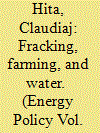

|
|
|
|
|
| Summary/Abstract |
Several studies note the large quantity of water used to hydraulically fracture oil and gas wells. We quantify this water use and its effects on water use for irrigating crops. For nine western states in 2017, water use in fracking represented 1.7 percent of water use in irrigation overall, but up to 55 percent in the Bakken shale of North Dakota, 28 percent in Oklahoma shale regions, and 12 percent in the Eagle Ford shale of Texas. However, in counties where the percentage of water use for fracking relative to irrigation is large, it is primarily because such counties have had minimal historical irrigation. We analyze the effect of state water policies governing the transfer of water from farming to fracking on water withdrawals for the two sectors. In North Dakota, which allowed farmers to forego irrigating and sell water to energy firms, each acre-foot of water used in fracking displaced about 1.1 acre feet from irrigation, thereby avoiding an increase in total withdrawals. Weaker evidence suggests an increase in irrigation in Oklahoma and Texas. Because of the lack of displacement in Texas and Oklahoma, concerns that fracking contributes to excess withdrawals in the present time may be warranted.
|
|
|
|
|
|
|
|
|
|
|
|
|
|
|
|
| 20 |
ID:
175263
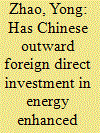

|
|
|
|
|
| Summary/Abstract |
China's soaring outward foreign direct investment (OFDI) in the energy sector has attracted increasing attention, which is arguably intended to enhance China's energy security given its large oil deficit. This study attempts to empirically examine whether OFDI in the energy sector can help to enhance China's energy security by conducting an econometric analysis using a micro-level dataset. The results show that China's OFDI in energy does enhance its energy security by increasing the volume of oil imports from host countries for the investment and by diversifying China's sources of imports. On average, a 1% increase in energy OFDI to a country leads to a 1.2% increase in the probability of importing from that country and a 0.071% increase in the firm-level import volume. In addition, we find that the effects do not differ by investment mode (i.e. mergers and acquisitions or greenfield investments) but do differ by country type, as investments in developing countries can positively contribute to oil imports, whereas investments in developed countries do not have the same effect.
|
|
|
|
|
|
|
|
|
|
|
|
|
|
|
|
|
|
|
|
|